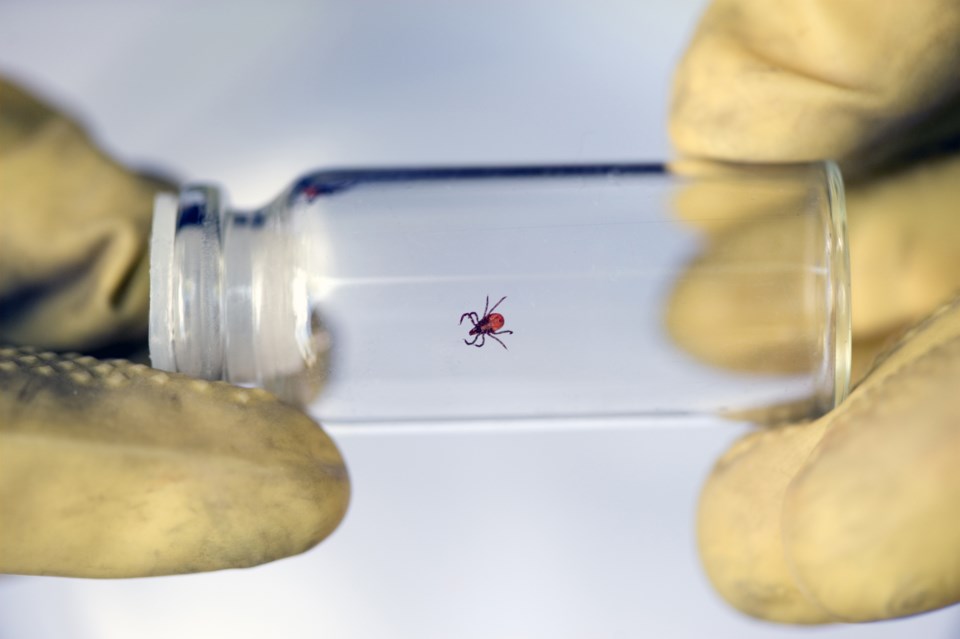PUSLINCH – Many Puslinch residents are reporting more ticks this season in a region WDG Public Health calls a “high-risk area” for lyme disease carrying blacklegged ticks.
On Facebook group What’s Happening Puslinch, a woman said she found ticks on herself, children and many on her dogs. Dozens of comments poured in with other Puslinch residents reporting the same with some identifying them as blacklegged ticks, which are better known as deer ticks.
Kaite Clow, assistant professor at University of Guelph and expert in ticks and tick-borne diseases, said this general region is considered an area of change.
“The sort of Hamilton, north of Hamilton, even up into the Milton area we’ve started finding blacklegged ticks,” Clow said. “The Puslinch area is certainly an area of monitoring.”
Clow noted that on etick.ca, an online tick monitoring system in Canada, there are reports from Puslinch residents of both kinds of ticks.
She explained that public health would label an area as high-risk through tick dragging, which is where a white flannel cloth is dragged over vegetation in search of ticks.
“That means health officials have been out in the spring and the fall and they’ve detected blacklegged ticks during sampling and it's considered a risk area,” Clow said.
Much of Puslinch is forested and Clow said blacklegged ticks are found in forests and brushy areas around them.
Some of the users on What’s Happening Puslinch speculated that it could be a bad year for ticks because of a mild winter.
Clow said in her surveillance, tick numbers were much higher in 2019 than 2018.
However, tick populations can be hard to judge and numerous factors play into their activity over their two-year plus life cycle.
“Different things that happen in the climate over that two years could impact tick populations,” Clow said. “Sometimes it can be hard to know why we’re seeing a lot of ticks a specific year and it could even be something that happened two years ago.”
Clow said that this year’s milder winter and slightly earlier warm temperatures may have extended tick activity season but stressed that a harsh winter doesn’t necessarily knock back the population.
The pandemic closures could be causing people to come in contact with them more often as hiking is for the most part permitted.
“As we are forced to stay home right now and the only reprieve from that is getting outside and going for hikes so we might be doing more of that, especially with our pets,” Clow said.
Clow said the biggest risk in Ontario with deer ticks is the possibility of them transmitting bacteria that causes lyme disease. She recommends exercising caution when outside in potential tick-prone areas.
“Sticking to marked, groomed trails is a great way to decrease your likelihood of coming in contact with them,” Clow said.
Other recommendations from Clow are using DEET, covering your skin in light-coloured clothing and performing a thorough check when you get home. For pets she said to speak with a veterinarian about tick prevention options.
WDG Public health is not taking in-person tick samples at this time. Clow said overall tick testing has decreased because it takes a long time and isn’t indicative of if you will get sick or not.
“Tick testing isn’t really recommended as part of clinical medicine practice anymore,” Clow said. “Tick testing is important from a research and surveillance point-of-view because then we know what is circulating in an area and what the health risk from tick bites are.”
She suggests taking a picture of the tick and submitting it to etick.ca. Clow said knowing the species of tick is very important and etick.ca will let you know in 24-48 hours.
“It’s really helpful because it’s going to tell you what type of tick it is and it gives you information to bring to your doctor and discuss what your next steps should be,” Clow said.



